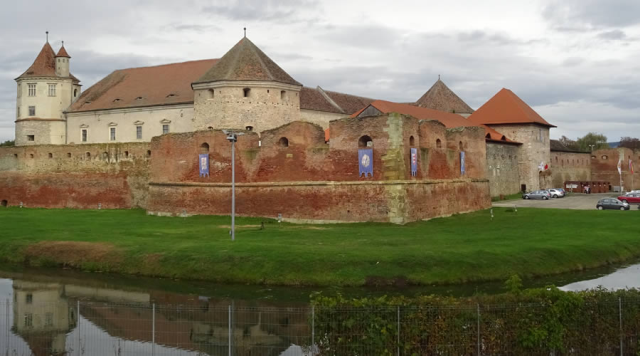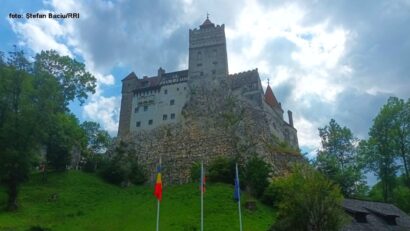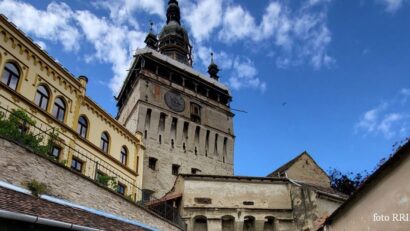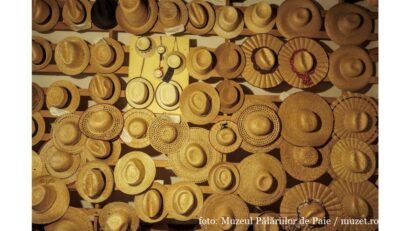The Fagaras Citadel, among the world’s most beautiful such edifices
A neat retrieval of Transylvania's most beautiful monuments

Daniel Onea, 10.08.2023, 13:50
Our stopover today is Brasov County, where we will get to know one of Romania’s best-preserved monuments. A great number of publications worldwide have written that it is one of the world’s most beautiful citadels. The Fagaras Citadel, for which construction works were completed in the 16th century, was besieged 26 times, but it was never conquered. Today, on the premises, inside the citadel, we can find the Valer Literat, Fagaras Country Museum, whose doors have been opened for us by the director, Elena Băjenaru.
The Fagaras Citadel, the Fagaras Country area’s most important historical monument, is a historical monument built over 600 years ago by Wallachia’s ruling princes. It is a citadel for which, as we speak, the final stage is carried, of a restoration project implemented with European funding. In our citadel, the tourist has access crossing a wooden bridge, rebuilt as part of the project, just as it was in the 17th century. It is a citadel which, as we speak, is one of Romania’s best-preserved defense citadels, surrounded by a moat, also built sometime in mid-16th century. It is a citadel surrounded by two massive defense walls with four bastions. Actually, this citadel, which has a perfectly developed defense system, has never been conquered in an armed confrontation, yet it was looted several times.
Before entering the museum and before visiting the castle, the tourists can take an outer circuit of the premises. With details on that, here is Elena Bajenaru once again.
They can see the bastions, the two defense walls, they can take a walk along the sentry road, rebuilt and restored just as it was in the 17th century. In one of the bastions an exhibition is to be mounted, dedicated to the Fagaras Citadel’s guard. We have a citadel guard and we re-enact a ceremony for the opening and closing of the gates, just as it was in the 17th century, during the reign of one of the citadel’s princesses, Anna Bornemisza. Then they can enter a very beautiful inner courtyard, in the middle of which the 17th century fountain was restored. They can climb up the stairs and, beginning with the 1st floor, they can enter the museum. In the museum, we present one ne hand, the history of the Fagaras Country, an area with a very rich history. They can also have the chance to see period realignments as part of that exhibition circuit. We have restored the Hall of the Assembly, the Assembly of Transylvania, Transylvania’s Government and Parliament as it was at that time, we restored the bedroom of one of the Fagaras Citadel’s princesses, Anna Bornemisza and, of course, access is also provided to exhibitions of decorative art, fine arts, peasant crafts, or temporary exhibitions. On the second floor we have arranged four rooms. We call them the Throne Hall. In the 17th century record books, they were entered as The Great Palace, there where the Transylvanian princes received in audience the envoys of the European powers. Miron Costin, but also the king of Poland, Sobiesky, were accommodated in this room. Now these four rooms have a cultural purpose. We stage cultural events, classical and medieval music concerts, cultural activities in general, and they are spectacular.
The citadel’s restoration project will be completed by the end of May, while as soon as that is achieved, beginning June 1st, the ceremony for the opening and closing of the gates will be resumed. Then you can see the citadel guard, made of 12 soldiers clad in the 17th century armour and there is also one of the citadel’s princesses who will show up, reading a document issued around the year 1678. In another move, the director of the Valer Literat, Fagaras Country Museum, Elena Bajenaru said, it is interesting we can establish a connection between torture and the citadel, for at least two reasons.
In the citadel, after 1700, a torture mechanism was brought, known as the Iron Maid. It is a mechanism that was first documented in Spain, somewhere around 1515, when the one who was sentenced to death was sent to kiss, as a last homage, an image of the Virgin Mary hanging on the body of that mechanism. The culprit approached the mechanism and, as he was stepping on a manhole, a couple of knives darted from behind, penetrating the body of the one who was sentenced. The manhole snapped open and the body fell into a channel where several spears were placed, having the points upwards. The channel communicated with Olt river, flowing 700-800 away from the citadel. Then the Făgăraș Citadel has a Prison Cell Tower that used to be a pretty tough medieval prison, as well as a communist prison for a decade, between 1950 and 1960, with almost 5,000 political detainees being imprisoned here.
During the summer season, which is drawing near, if you hit the Fagaras Citadel, you can take part in unforgettable events.
Elena Bajenaru once again.
Apart from the cultural projects, temporary exhibitions, book launches, we stage a medieval festival in the last weekend of August. It is a medieval festival with knightly orders participating, from Transylvania and elsewhere in Romania. We have medieval theatre performances, medieval music concerts, classical music concerts, medieval theatre, combat demonstrations, smithy workshops, everything that was and can still be associated with the activities revolving around this medieval citadel. Then, on our way out of the exhibition circuit, we have a very well-stocked souvenir shop. We also have citadel guides in English and Hungarian, we have books in English about Transylvania, about the most important monuments Romania has, apart from what we usually offer as souvenirs to go with the Fagaras Citadel.
Nearby Fagaras Citadel there are two other monuments the director of the Valer Literat Fagaras Country Museum, Elena Bajenaru, strongly recommends the tourists to visit, should they spend more time in the area.
First of all, I should send them to visit the church built by Brâncoveanu in late 17th century, somewhere around 1697, for two reasons, at least. The church is endowed with a very beautiful painting, made by Preda the Painter, also because the altar piece of that little church could be viewed as the most beautiful altar piece of the entire Brancoveanu-era art. It also lies very close to the citadel, so it is worth visiting it. I should also recommend tourists to visit the Roman-Catholic Church, a former Franciscan monastery, which also lies close by . It is known as one of Transylvania’s first churches with a Baroque-style painting.
So here we have an interesting tourist destination. Beginning June the 1st, it waits for you with its doors wide open, but also with very many and extremely diverse events.






























